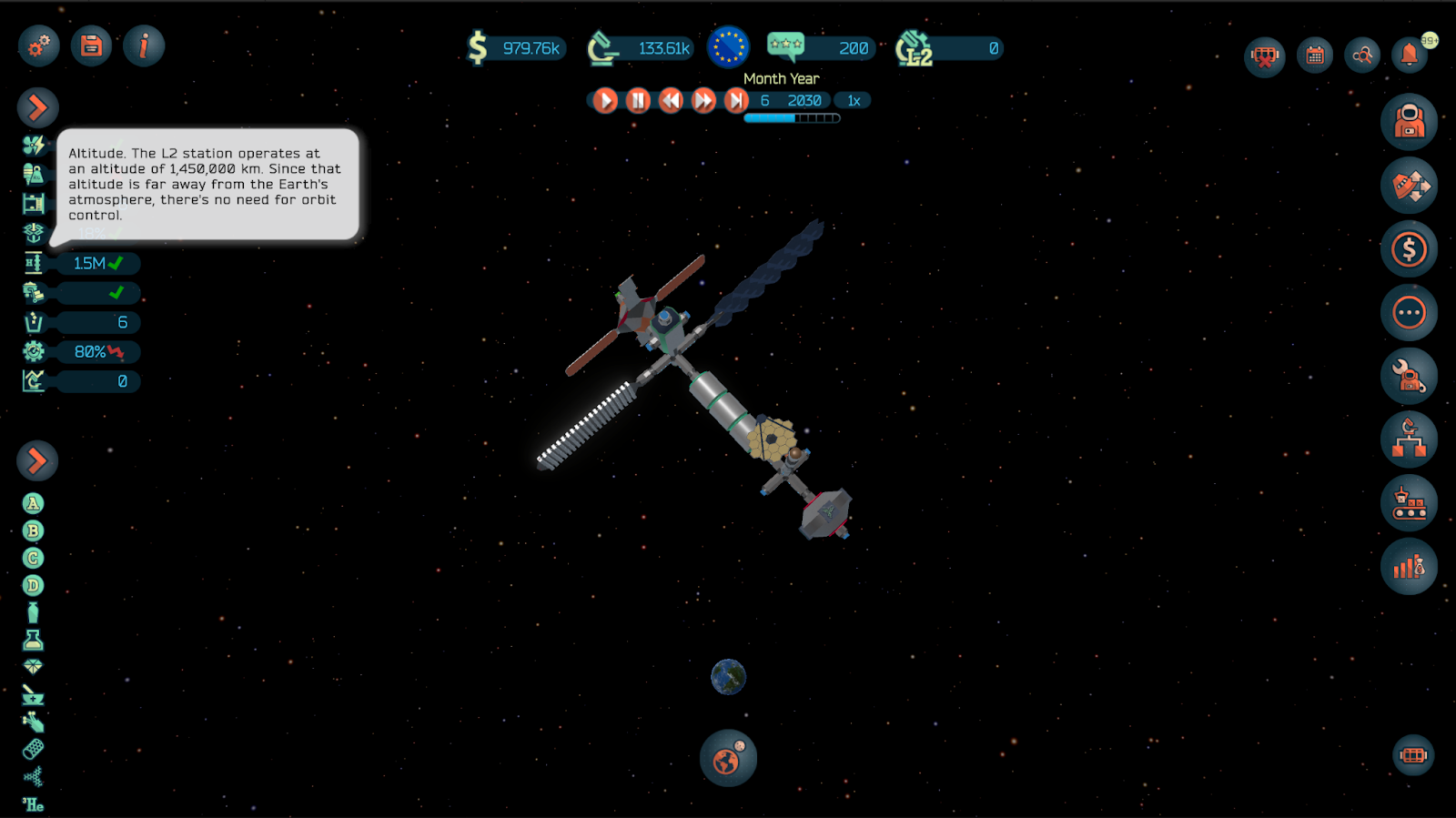Welcome to the eleventh Dev Diary entry of 'Space Station Designer'. In the previous entry, we started a two-part series that covers the two stations available in higher Earth orbits. The previous entry discussed the details behind the station in Geosynchronous Orbit (GSO). In this entry, we'll analyse the station in the Sun-Earth Lagrange Point 2 (L2) and what makes it unique.
The Sun-Earth Lagrange Point 2 (L2) Orbit
The Sun-Earth Lagrange Point 2 (L2) is a location in space 1.5 million km behind Earth, as viewed from the Sun. It's a gravitationally stable point where the combined gravitational forces of the Sun and Earth balance the centrifugal force, which allows the station to orbit the Sun in sync with Earth with minimal fuel consumption. Because of this, L2 is an ideal location for space observatories like the James Webb Space Telescope, which require a stable, unobstructed view of deep space. Since a spacecraft in L2 is in a fixed point in space relative to the Earth, it doesn't go through a constant cycle of passing in and out of the Earth's shadow, which simplifies its cooling requirements. In the context of 'Space Station Designer', the L2 station provides an excellent location for conducting scientific research and manufacturing that cannot be done in other orbits.

Altitude, Orbit Control, and Attitude Control
As mentioned earlier, the L2 station operates at an altitude of approximately 1.5M km from the surface of the Earth. At such high altitude, the influence of Earth's atmosphere is nil. Because of this, the L2 station has no need for 'orbit control'. Note that, similar to what happens in the GSO station, the L2 station is still subject to the occasional orbital debris shower. It's important to ensure that we keep a healthy 'attitude control' score to minimize the chances of experiencing damage.

Manufacturing of Organic Scintillators
In addition to being capable of producing the regular commercial goods (i.e., Ceramics, Chemicals, Crystals, Pharmaceuticals, and Fiber Optics), the L2 station has specialized manufacturing modules that can produce 'Organic Scintillators'. These are a type of organic material that provide detectable photons in the visible part of the light spectrum.
Scintillators have practical applications in the development of radiation-detecting equipment (e.g., scanners and equipment used in airports and medical labs), and while they can be created on Earth, exposing them to the type of radiation present in L2 during the manufacturing process gives them unique properties that make them very valuable.

The 'Organic Scintillators' manufacturing modules can be found in the modules screen and, just like other types of production modules, there are a few variants available with a range of electricity/heat dissipation requirements, and throughput. The largest version offers the best throughput, but it can be quite expensive compared to the small and medium ones, so it's important to weigh our options carefully.

Resupply spacecraft transfers and space tourism
Since the L2 point is located so far away from the Earth, it takes a considerable amount of time and propulsion reserves to get there, along with a larger heatshield to withstand the fiery re-entry. Because of this, only a subset of all available resupply spacecraft can visit the L2 station. And for this reason, space tourism isn't available in the L2 orbit either.

Coming Up Next
This blog post covered the second type of station available in higher Earth orbit, along with the features and capabilities that make it unique. In the next Dev Diary, we'll be starting a two-part series discussing all the details behind the 'Lunar Orbit' station, which is crucial for the development of the 'Lunar Space Elevator' megaproject.
We're currently running a closed beta for 'Space Station Designer' (more information here). A few weeks ago we released a very large update featuring loads of changes to the visuals, new gameplay elements, and several QoL improvements. We're currently hard at work on the next update, which will include a large number of improvements and a completely revised set of interactive tutorials. If you're interested in trying out 'Space Station Designer', please consider applying to the closed beta and help us shape its future.
See you in the next Dev Diary!
--Ignacio, Mauricio, and Nicolas (Polar Motion)






